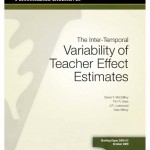The Inter-Temporal Variability of Teacher Effect Estimates
School districts have begun using estimates of teachers’ effects on student test scores (or “valueadded) for diagnostic purposes and allotting monetary rewards. Such estimate must be precise enough to identify high- and low-performing teachers and predict future performance accurately. We study the inter-temporal variability in value-added measures for elementary and middle school mathematics teachers from five large Florida school districts. Consistent with worker productivity measures in other occupations, teacher estimates are moderately stable, with year-to-year correlations ranging from 0.2-0.5 for elementary school and 0.3-0.7 for middle school teachers. Thirty to 60 percent of the variation in measured teacher performance is due to sampling error from “noise” in student test scores. Persistent teacher effects account for about 50 percent (70 percent) of the variation not due to noise for elementary (middle) school teachers; other time-varying factors account for the remaining variance. However, observed teacher characteristics (e.g., experience, advanced degrees and professional development) explain little inter-temporal variation unrelated to sampling errors. Averaging estimates from two years greatly enhances the stability of the estimates and improves their predictive ability. We also explore the sensitivity of stability to the value-added model specification and the achievement test.
To read this paper, please click here .

Connect with Vanderbilt
©2026 Vanderbilt University ·
Site Development: University Web Communications